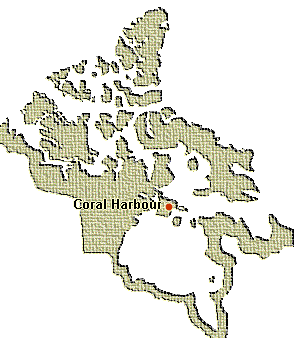Coral Harbour ᓴᓪᓕᑦ
Saint Joseph and the Mother of the Saviour
Foundation of the Roman Catholic Mission
In 1926 when two oblates Fr. Emmanuel Duplain and Br. Prime Girard founded St. Joseph Mission on the Southampton Island there were about 220 Inuit living in the area. Some were Aivilingmiut, coming from the West, and others, Uqqumiut, coming from the East. The first were considered to be the best walrus hunters, the dog-sled experts and especially, because they had worked with American whalers, the preferred employees of the whites. Their women, in turn, were said to be the most expert boot makers. The second group, less numerous, had been transported from Baffin Island on the ship Nascopie by the Hudson Bay Company, in order to assure an adequate number of trappers to take advantage of the abundant fox resources on the island.
Oblates That Served the Parish:
- Fr. Emmanuel Duplain, 1926-1928
- Br. Prime Girard, 1926
- Fr. Eugene Fafard, 1927-1933
- Fr. Armand Clabaut, 1930
- Fr. Arthur Thibert, 1927-1930
- Fr. Joseph Masse, 1931-1934
- Fr. Paul-Henri Dionne, 1933-1935
- Fr. Jean Philippe, 1942-1944
- Fr. Marcel Rio, 1944-1954
- Fr. Roland Courtemanche, 1946-1947
- Fr. Joseph Choque, 1954-1963
- Fr. Theophile Didier, 1963-1965
- Fr. Hubert Mascaret, 1965-74, 1976-87
- Fr. Rogatien Papion, 1975-1977
- Fr. Louis Fournier, 1996-2002
About the Town:

The community of Coral Harbour is located on the Southampton Island, surrounded by the waters of the Hudson Bay. The island was named by Thomas Button, explorer searching for the Northwest Passage, after his benefactor who helped his expedition in 1604.
The Inuktituk name of the town, Salliit, means an island, large and flat, located in front of the mainland.
In the nineteenth century the island was visited by whalers on the occasion of their hunt for the bowhead whale. They came in contact with a group of the Inuit, called Sallirmiut, who in the early twentieth century faced almost complete extinction, due to the unknown before diseases, brought by the crew of one of the European ships. Remains of a large Sallirmiut camp exists still at Native Point, southeast of Coral Harbour.
Since the opening of the Hudson Bay Company’s trading post on the Southampton Island in the 1924, Inuit started to settle in this area, moving from the mainland, from Baffin Island and as far as from the northern Quebec.
A large military base was build close to Coral Harbour during the Second World War. This American base, now abandoned, is protected under the territorial law.
In 1950 the federal government built a school in Coral Harbour. From then on the Inuit were encouraged to move from their camps into a permanent settlement. Today the population of Coral Harbour is reaching almost 900 people (822 according to the estimates from the year 1999).
What could be said finally is that the area of Coral Harbour is known for diversity of wildlife - from beluga whales, walrus and seals to caribou, polar bears and finally many species of migratory birds.
[If you are looking for further general information about the town, a good place to visit is The 2004 Nunavut Handbook .]

